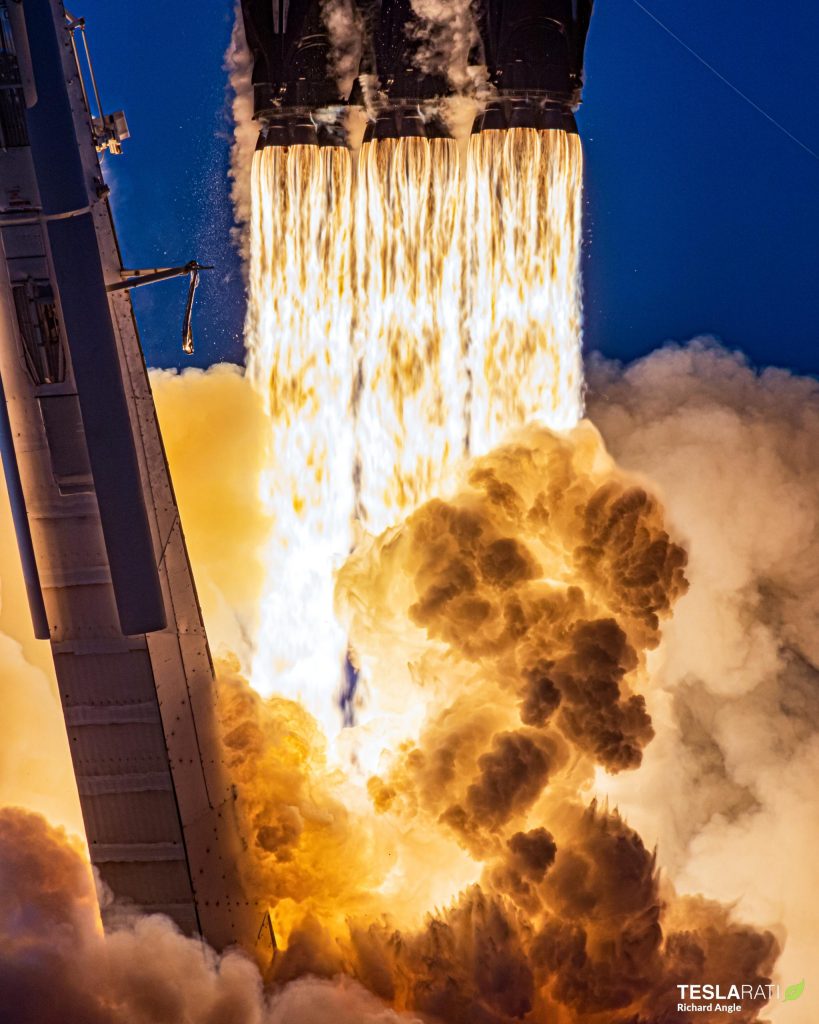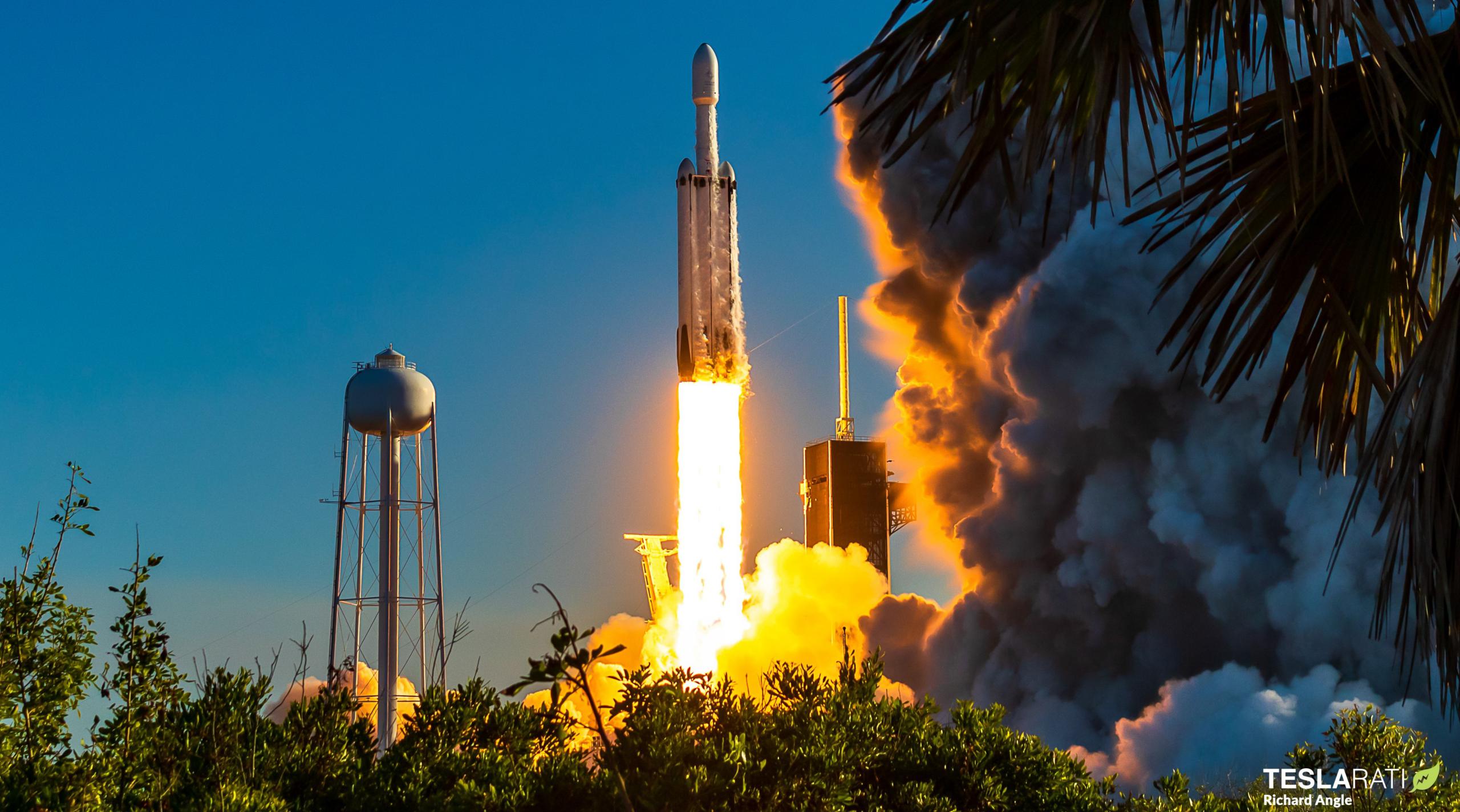In a statement issued to Bloomberg, the US Space Force says that SpaceX’s Falcon Heavy rocket could still conduct its first operational launch for the military before the end of the year.
That’s a large downgrade from late 2021 and early 2022, when – lacking any new information from the US military – it appeared that SpaceX could launch up to three Falcon Heavy rockets for military customers over the course of the year. Around eight months later, the world’s most powerful and capable operational rocket – backed by a strong manifest of 11 firm launch contracts – hasn’t flown once since June 2019. At that time, the rocket’s next launch was already expected no earlier than late 2020 – a roughly 18-month gap.
Instead, thanks to largely unspecified problems that have relentlessly delayed the completion of the satellites Falcon Heavy is supposed to launch, the rocket’s fourth flight is now unlikely to occur less than ~40 months after its third. Thankfully, a new Space Force decision should at least dull the pain caused by the endless shuffling of Falcon Heavy’s near-term launch manifest.
Alongside a slight schedule update stating that SpaceX’s first operational Falcon Heavy launch for the US military could still happen sometime from “October to December” 2022, the Space Force statement issued to Bloomberg mainly revealed the military branch’s June decision to permit SpaceX’s use of reused Falcon Heavy boosters on upcoming launches. While Bloomberg did not publish the statement in full or explain what the decision truly entails, the implication is that the Space Force will now let SpaceX assign flight-proven Falcon boosters – with US military oversight – to its military missions.
The US military will likely retain the ability to veto or modify SpaceX’s booster assignments and reuse sequencing, but the Space Force told Bloomberg that it’s confident that the “recovery, refurbishment, and launch of SpaceX boosters utilizes well-established processes.” In fact, the US military has already approved the use of flight-proven Falcon 9 boosters, several launches of which have since occurred, and even allowed SpaceX to fly two reused Falcon Heavy side booster’s on the rocket’s first (test) launch for the military.
It’s no surprise that that acceptance would eventually grow to include Falcon Heavy, which is similar to Falcon 9 in many ways. That it took the USSF until June 2022, three full years after STP-2 demonstrated the successful reuse of two Falcon Heavy boosters at once, to fully approve it is arguably far more surprising.

SpaceX will likely be able to plan for future Falcon Heavy launches more easily knowing that the US military should – in theory – be okay with the company reusing boosters on upcoming launches. That would be especially true if the military is comfortable with SpaceX reusing Falcon Heavy boosters that have supported non-military launches. After numerous delays, only one non-military mission – ViaSat’s first ViaSat-3 geostationary communications satellite – still claims to have a shot at a 2022 launch, but that target has slipped from spring, late-summer, and September 2022 to Q4 2022 since late 2021.
At one point, the US military’s USSF-44, USSF-52, and USSF-67 missions were all scheduled to launch on Falcon Heavy in 2022. Now, one reliable source states that USSF-44 and USSF-52 are indefinitely delayed, while another indicates that USSF-44 has slipped to December 2022 and USSF-52 to April 2023. Meanwhile, EchoStar’s Jupiter-3 commsat recently slipped to Q1 2023 and NASA’s Psyche asteroid explorer ran into software issues that delayed its Falcon Heavy launch from August/September 2022 to July or September 2023.
That leaves ViaSat-3 and USSF-67, both of which could launch in Q4 2022. But given just how delay-ridden ViaSat-3 has been and how temperamental all military Falcon Heavy payloads have been, the most likely outcome may already be zero Falcon Heavy launches in 2022.
News
These Tesla, X, and xAI engineers were just poached by OpenAI
The news is the latest in an ongoing feud between Elon Musk and the Sam Altman-run firm OpenAI.

OpenAI, the xAI competitor for which Elon Musk previously served as a boardmember and helped to co-found, has reportedly poached high-level engineers from Tesla, along with others from xAI, X, and still others.
On Tuesday, Wired reported that OpenAI hired four high-level engineers from Tesla, xAI, and X, as seen in an internal Slack message sent by co-founder Greg Brockman. The engineers include Tesla Vice President of Software Engineering David Lau, X and xAI’s head of infrastructure engineering Uday Ruddarraju, and fellow xAI infrastructure engineer Mike Dalton. The hiring spree also included Angela Fan, an AI researcher from Meta.
“We’re excited to welcome these new members to our scaling team,” said Hannah Wong, an OpenAI spokesperson. “Our approach is to continue building and bringing together world-class infrastructure, research, and product teams to accelerate our mission and deliver the benefits of AI to hundreds of millions of people.”
Lau has been in his position as Tesla’s VP of Software Engineering since 2017, after previously working for the company’s firmware, platforms, and system integration divisions.
“It has become incredibly clear to me that accelerating progress towards safe, well-aligned artificial general intelligence is the most rewarding mission I could imagine for the next chapter of my career,” Lau said in a statement to Wired.
🚨Optimistic projections point to xAI possibly attaining profitability by 2027, according to Bloomberg's sources.
If accurate, this would be quite a feat for xAI. OpenAI, its biggest rival, is still looking at 2029 as the year it could become cash flow positive.💰 https://t.co/pE5Z9daez8
— TESLARATI (@Teslarati) June 18, 2025
READ MORE ON OPENAI: Elon Musk’s OpenAI lawsuit clears hurdle as trial looms
At xAI, Ruddarraju and Dalton both played a large role in developing the Colossus supercomputer, which is comprised of over 200,000 GPUs. One of the major ongoing projects at OpenAI is the company’s Stargate program,
“Infrastructure is where research meets reality, and OpenAI has already demonstrated this successfully,” Ruddarraju told Wired in another statement. “Stargate, in particular, is an infrastructure moonshot that perfectly matches the ambitious, systems-level challenges I love taking on.”
Elon Musk is currently in the process of suing OpenAI for shifting toward a for-profit model, as well as for accepting an investment of billions of dollars from Microsoft. OpenAI retaliated with a counterlawsuit, in which it alleges that Musk is interfering with the company’s business and engaging in unfair competition practices.
Elon Musk confirms Grok 4 launch on July 9 with livestream event
News
SpaceX share sale expected to back $400 billion valuation
The new SpaceX valuation would represent yet another record-high as far as privately-held companies in the U.S. go.

A new report this week suggests that Elon Musk-led rocket company SpaceX is considering an insider share sale that would value the company at $400 billion.
SpaceX is set to launch a primary fundraising round and sell a small number of new shares to investors, according to the report from Bloomberg, which cited people familiar with the matter who asked to remain anonymous due to the information not yet being public. Additionally, the company would sell shares from employees and early investors in a follow-up round, while the primary round would determine the price for the secondary round.
The valuation would represent the largest in history from a privately-owned company in the U.S., surpassing SpaceX’s previous record of $350 billion after a share buyback in December. Rivaling company valuations include ByteDance, the parent company of TikTok, as well as OpenAI.
Bloomberg went on to say that a SpaceX representative didn’t respond to a request for comment at the time of publishing. The publication also notes that the details of such a deal could still change, especially depending on interest from the insider sellers and share buyers.
Axiom’s Ax-4 astronauts arriving to the ISS! https://t.co/WQtTODaYfj
— TESLARATI (@Teslarati) June 26, 2025
READ MORE ON SPACEX: SpaceX to decommission Dragon spacecraft in response to Pres. Trump war of words with Elon Musk
SpaceX’s valuation comes from a few different key factors, especially including the continued expansion of the company’s Starlink satellite internet company. According to the report, Starlink accounts for over half of the company’s yearly revenue. Meanwhile, the company produced its 10 millionth Starlink kit last month.
The company also continues to develop its Starship reusable rocket program, despite the company experiencing an explosion of the rocket on the test stand in Texas last month.
The company has also launched payloads for a number of companies and government contracts. In recent weeks, SpaceX launched Axiom’s Ax-4 mission, sending four astronauts to the International Space Station (ISS) for a 14-day stay to work on around 60 scientific experiments. The mission was launched using the SpaceX Falcon 9 rocket and a new Crew Dragon capsule, while the research is expected to span a range of fields including biology, material and physical sciences, and demonstrations of specialized technology.
News
Tesla Giga Texas continues to pile up with Cybercab castings
Tesla sure is gathering a lot of Cybercab components around the Giga Texas complex.

Tesla may be extremely tight-lipped about the new affordable models that it was expected to start producing in the first half of the year, but the company sure is gathering a lot of Cybercab castings around the Giga Texas complex. This is, at least, as per recent images taken of the facility.
Cybercab castings galore
As per longtime drone operator Joe Tegtmeyer, who has been chronicling the developments around the Giga Texas complex for several years now, the electric vehicle maker seems to be gathering hundreds of Cybercab castings around the factory.
Based on observations from industry watchers, the drone operator appears to have captured images of about 180 front and 180 rear Cybercab castings in his recent photos.
Considering the number of castings that were spotted around Giga Texas, it would appear that Tesla may indeed be preparing for the vehicle’s start of trial production sometime later this year. Interestingly enough, large numbers of Cybercab castings have been spotted around the Giga Texas complex in the past few months.
Cybercab production
The Cybercab is expected to be Tesla’s first vehicle that will adopt the company’s “unboxed” process. As per Tesla’s previous update letters, volume production of the Cybercab should start in 2026. So far, prototypes of the Cybercab have been spotted testing around Giga Texas, and expectations are high that the vehicle’s initial trial production should start this year.
With the start of Tesla’s dedicated Robotaxi service around Austin, it might only be a matter of time before the Cybercab starts being tested on public roads as well. When this happens, it would be very difficult to deny the fact that Tesla really does have a safe, working autonomous driving system, and it has the perfect vehicle for it, too.
-

 Elon Musk1 week ago
Elon Musk1 week agoTesla investors will be shocked by Jim Cramer’s latest assessment
-

 News2 weeks ago
News2 weeks agoTesla Robotaxi’s biggest challenge seems to be this one thing
-

 Elon Musk1 day ago
Elon Musk1 day agoElon Musk confirms Grok 4 launch on July 9 with livestream event
-

 News2 weeks ago
News2 weeks agoWatch the first true Tesla Robotaxi intervention by safety monitor
-

 News5 days ago
News5 days agoTesla Model 3 ranks as the safest new car in Europe for 2025, per Euro NCAP tests
-

 Elon Musk2 weeks ago
Elon Musk2 weeks agoA Tesla just delivered itself to a customer autonomously, Elon Musk confirms
-

 Elon Musk2 weeks ago
Elon Musk2 weeks agoElon Musk confirms Tesla Optimus V3 already uses Grok voice AI
-

 Elon Musk2 weeks ago
Elon Musk2 weeks agoxAI welcomes Memphis pollution results, environmental groups push back


















